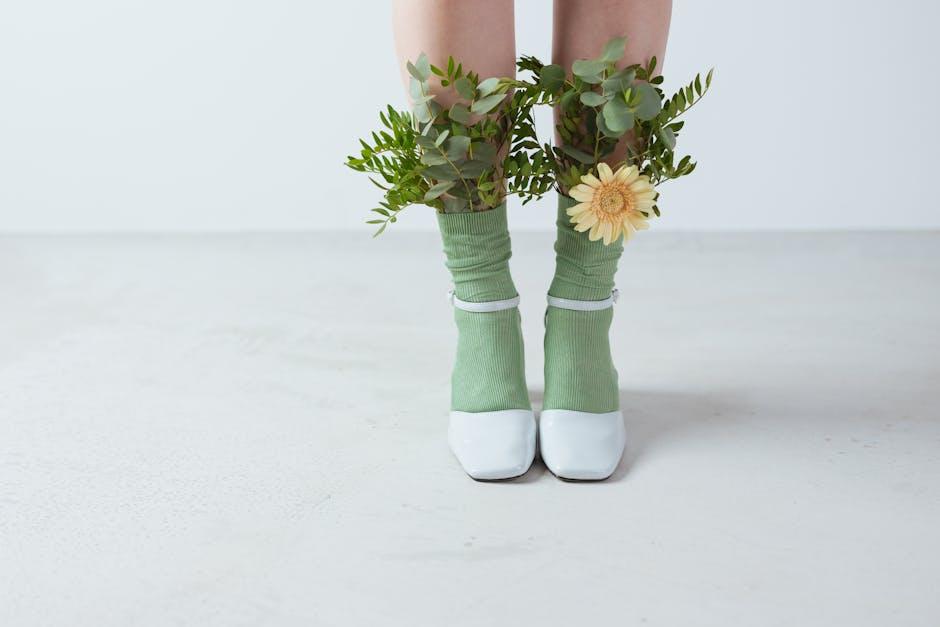In a world where every choice we make leaves a footprint—sometimes literal adn often environmental—our everyday essentials are quietly contributing too a larger crisis. Among them, an unlikely hero emerges: the humble sock. As we navigate the intricate tapestry of sustainable living, the socks we slip on each morning have the potential to play a pivotal role in reducing microplastic pollution. With the average person discarding dozens of pairs each year, the impact on our planet is staggering. This article explores the innovative strides being made in the sock industry, highlighting eco-amiable materials, responsible manufacturing processes, and the transformative impact that conscious consumerism can have. Join us as we delve into how our simplest choices can help tread lightly on the Earth, one step at a time.
the hidden Impact of Microplastics in Everyday Wear
Although often overlooked,the materials used in our clothing—especially in activewear and socks—contribute significantly to microplastic pollution. Every time we wash these items, tiny fibers are released into the water system, eventually making their way into oceans and rivers. These microplastics can be ingested by marine life, infiltrating the food chain and posing risks to both animals and humans. The impact is troubling, as socks alone usually contain a blend of synthetic materials such as polyester and nylon, which can shed thousands of microplastic particles with each wash. Addressing this issue is crucial, and every consumer choice can make a difference.
To combat the hidden threats of microplastics, opting for sustainably produced socks made from natural fibers like organic cotton, bamboo, or recycled materials can be a strategic move. These alternatives not onyl minimize microplastic shedding but also promote environmentally responsible practices. Here are some benefits of choosing sustainable sock options:
- Reduction of Waste: Sustainable materials often utilize less energy and water during production.
- enhanced Durability: Natural fibers tend to be more resilient,reducing the need for frequent replacements.
- Healthier Choices: Organic materials are free from harmful chemicals, benefiting both wearers and ecology.
| Material | microplastic Release | Sustainability Rating |
|---|---|---|
| Polyester | High | Low |
| Nylon | High | Low |
| Organic Cotton | None | High |
| Bamboo | None | High |

Innovative Materials: Exploring Eco-friendly Alternatives for Sock Production
As the fashion industry continues to grapple with the pressing demand for sustainability, innovative materials are at the forefront of transforming sock production. Conventional materials like cotton and synthetic fibers contribute significantly to microplastic pollution, but brands are now exploring eco-friendly alternatives that promise to reduce environmental impact. Options such as recycled PET, derived from post-consumer plastic bottles, and bamboo, which grows rapidly without the need for pesticides, are gaining momentum. These materials not only minimize waste but also provide comfort, durability, and breathability, making them a popular choice among consumers conscientious about their ecological footprint.
Moreover, the advent of bio-based fibers presents exciting opportunities for sustainable sock production. Innovations in materials like Tencel, made from sustainably sourced wood pulp, and Hemp, known for its low water consumption during cultivation, are proving that eco-friendly does not mean sacrificing quality. Consider the key benefits of these materials:
- recycled PET: Reduces plastic waste and conserves resources.
- bamboo: Naturally biodegradable and hypoallergenic.
- Tencel: Comes from sustainable sources and has a lower carbon footprint.
- Hemp: Grows quickly and requires minimal water.

Choosing Brands with a conscience: How to Make Informed Purchases
When it comes to making environmentally conscious choices, understanding the brands behind the products we buy is crucial. Sustainable sock brands are leading the charge in combating microplastic pollution, often taking innovative steps to minimize their environmental footprint. Here are some key factors to consider when choosing guilt-free options:
- Materials used: Look for socks made from organic cotton, bamboo, or recycled fibers that break down more easily than traditional synthetics.
- Manufacturing Practices: Brands that prioritize ethical labor practices and energy-efficient production methods can help ensure a positive impact on communities and the planet.
- Openness: Choose companies that openly share their sourcing and manufacturing processes, as this can indicate a commitment to accountability.
To further guide your purchasing decisions, consider checking whether the brand participates in environmental initiatives or has third-party certifications. Here’s a simple comparison table of popular sustainable sock brands:
| Brand | Materials | Certifications | Eco-Initiatives |
|---|---|---|---|
| Bombas | recycled cotton | Certified B Corporation | Socks for homeless shelters |
| stance | Bamboo and merino wool | OEKO-TEX | Ocean cleanup projects |
| Thought | Organic cotton | GOTS | Tree planting with purchases |
The choices we make in our everyday lives can ripple out to create meaningful change, especially when we prioritize brands that align with our values.By learning about the impact of our purchases, we empower ourselves to contribute to a greener planet with every step we take.

Extending Lifespan: Caring Tips for Sustainable Socks to Minimize Waste
To ensure that your sustainable socks have a long and fruitful life, it’s essential to embrace a few mindful habits in their care. Washing your socks in cold water not only conserves energy but also helps maintain the integrity of the fibers, preventing microfibers from shedding during the wash cycle. When it comes to drying,consider air drying your socks rather than using a dryer.This simple switch can significantly reduce energy consumption and extend the lifespan of your cherished pairs.
Additionally, being conscious of how often you wear and wash your socks can make a big difference. Rotate your socks to give them time to breathe and maintain elasticity. keep an eye out for areas of wear and consider performing simple mends to keep them in circulation longer. Here’s a fast reference table to demonstrate the benefits of sustainable sock care practices:
| Care Practice | Benefit |
|---|---|
| Wash in Cold Water | Energy conservation |
| Air Dry | Fiber longevity |
| Rotate Wearing Schedule | Reduces wear and tear |
| Repair damages | Prolongs usage |
Key Takeaways
As we lace up our shoes and step into a world of choices, the power of seemingly small decisions becomes ever clearer.Sustainable socks are not just a fashion statement; thay are a stride towards a cleaner planet. By opting for materials that minimize microplastic pollution, we can walk lighter on the Earth and contribute to a healthier ecosystem. Each pair of eco-friendly socks represents a commitment to sustainability, reminding us that even the smallest steps can lead to significant change. As we navigate our daily paths, let’s choose wisely and wear our values, one foot at a time. In doing so, we not only protect the surroundings but also inspire others to embrace a greener future—as every step counts.




